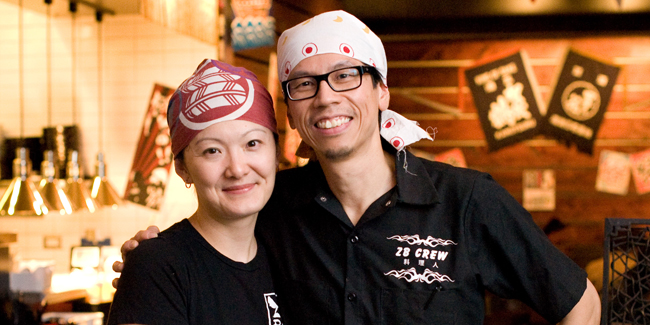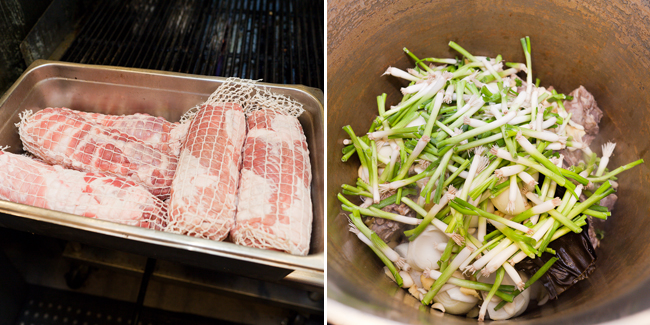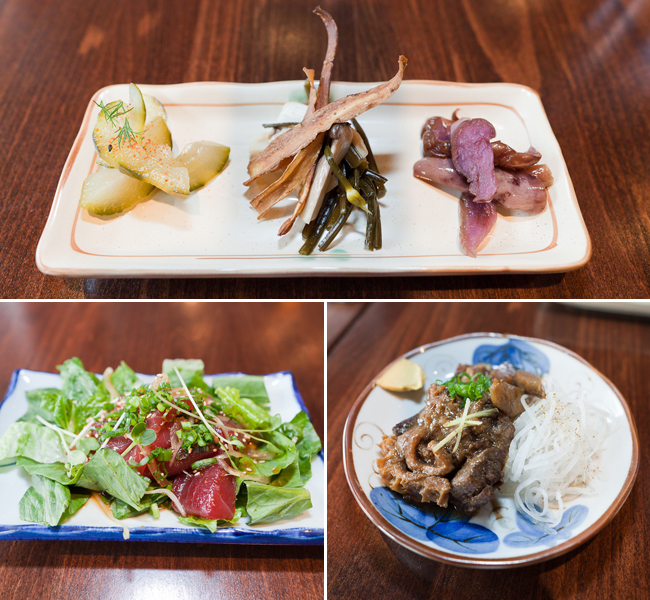
The breadth and depth of Japanese food spans a broad spectrum of flavor, with deep roots in focus and appreciation of ingredients. While sushi has made its presence known in the Midwest, it barely scratches the surface of the epicurean adventure that is Japanese cuisine. For those who seek a larger view, one of the best ways to experience the non-sushi side of Japanese cuisine is to visit an izakaya.
Simply put, izakaya are restaurants that serve food to accompany drinks — think Japanese style tapas. Izakaya menus are varied and diverse with dishes that range from braised “stews”, to noodles, to fried finger-foods. While izakaya menus sometimes include sushi, this would usually represent just a small portion of the overall menu.
Unfortunately for Minnesotans, the mass commercial appeal of sushi and the frequent hybridization of Asian cuisines (restaurants that offer Japanese, Chinese, and Thai dishes alongside each other) have limited the existence of traditional Japanese restaurants like the izakaya. In the metro area there are Japanese restaurants such as Tanpopo, Masu Robata, Obentoya, and Moto-i that began to bridge the gap between sushi-centric menus and izakaya. While these establishments did shed light on the non-sushi world of Japanese cuisine, the presence of a truer izakaya remained elusive in the Twin Cities.

That was until Zen Box Izakaya opened its doors just a couple of years ago. What started out as a downtown skyway lunch destination that served a variety of Japanese bento grew into a full izakaya restaurant. The husband and wife team that has led Zen Box Izakaya, John Ng and Lina Goh, came to the Twin Cities from San Francisco. We sat down with John and Lina and discussed their efforts to bring a more authentic, non-sushi flavor of Japanese dining to the local palate.
HEAVY TABLE: You strive toward “authentic” Japanese cuisine. What does that mean to you?
ZEN BOX: Our philosophy of “authentic” Japanese cuisine is the combination of ingredients, techniques, cooking processes, atmosphere, and service. Most importantly, we want our dishes to trigger memories and thoughts of Japan.
HT: What perception of Japanese food do you disagree with most?
ZB: Japanese food being identified as just sushi or anything served raw. We also disagree with Japanese food being confused with other Asian foods such as its association with cream cheese wontons, General Tso’s chicken, spring rolls, pho, etc.

HT: If a new customer walked in the door and tried just one item on the menu, which one would you want them to order? Why?
ZB: Most definitely our tonkotsu ramen. Ramen is one of the most consumed dishes in Japan, even more so than sushi. It is a very personal dish to John which he learned from his sensei (teacher) Koji Okada, one of the first ramen chefs that introduced the craft to San Francisco in the late 1980s. John learned the art of ramen and the traditional cooking process and techniques, with emphasis on the broth (body), tare (base flavor), and aroma (infused oils) to make the perfect broth.

The base broth for Zenbox Izakaya’s selection of ramen is created with a multitude of ingredients — kombu, green onions, ginger, garlic, roasted chicken and pork bones, onions, and rolled portions of pork belly. Chicken and pork bones, when boiled at high temperatures for long periods of time, lend the broth greater flavor and a creamier consistency. This methodology is used in two of the most popular styles of ramen broth: tonkotsu and paitan.
HT: Tell us a little more about your tonkotsu ramen (below, left).
ZB: Our tonkotsu ramen is really the soul of everything we are trying to do in this izakaya. It is a dish that is very important to John. To us it is the perfect marriage of our Chinese heritage (ramen was originally created in China before being popularized in Japan) and our passion for Japanese culture.
HT: The tonkotsu ramen broth exudes umami flavor with a slightly rich and creamy finish. It definitely reminds us of ramen broths we might find in California or Japan. Would you say your tonkotsu ramen broth is authentic?
ZB: For us authenticity has a lot to do with the traditional process of making the broth. You could make ramen from a packet, or you can put in all the work and techniques we use (it takes 10-12 hours to make a batch of tonkotsu broth). We do add our unique touch to the broth through the roasting of the bones, but otherwise we stay as true to the traditional Japanese process as possible.
HT: On the topic of roasting the bones for your broth, the subtle smokiness from roasting gives the broth a fuller taste that lingers on the palate. It’s a slight yet satisfying addition to the ramen.

HT: How is the veggie ramen made (above, right)?
ZB: We use different kinds of vegetables that are roasted with spices. Roasting extracts the flavors of the vegetables which we add to the broth. Kombu and shiitake mushrooms also add an initial layer of umami flavor into the broth. This vegetable ramen broth takes about 8 hours to make.
HT: Since we’re used to traditional ramen broths, we didn’t know what to expect of a vegetarian ramen. But the mushrooms and roasted vegetables work well to create a full, satisfying flavor without the use of bones or meat. The tofu chips are a nice touch as well.
ZB: We added the tofu chips to give the ramen texture. To us a successful dish should have taste, aroma, and texture.

HT: These pickled vegetables (above, top) are excellent. There’s a lot of variety in flavor from citrus undertones to bold sour flavors. How do you make these and how do pickled vegetables fit into your menu?
ZB: We use simple pickling techniques and in certain items add additional elements like yuzu, umeboshi, and infused shochu. The pickles help to cleanse your palate as you sample different dishes. They also pair well with drinks.
HT: Tell us about the motsu nikomi (above, bottom right).
ZB: Motsu nikomi is one of the most classic izakaya dishes. Every izakaya has its own unique version of this dish. Ours uses a red miso base with beef brisket, tripe, and gobo (burdock root).
HT: The flavor of the tripe is certainly there but the flavor is more subtle in this preparation. The dish has a lot of very strong and delicious flavors in it, with a great balance of bite from the miso and daikon radish.
ZB: We know a lot of people might not like the texture or taste of tripe, but the gobo and red miso really help to balance and mask some of that. To be honest this is not very popular here (in Minnesota), but we think it is important to have it on the menu because it is such a classic Japanese izakaya dish.
